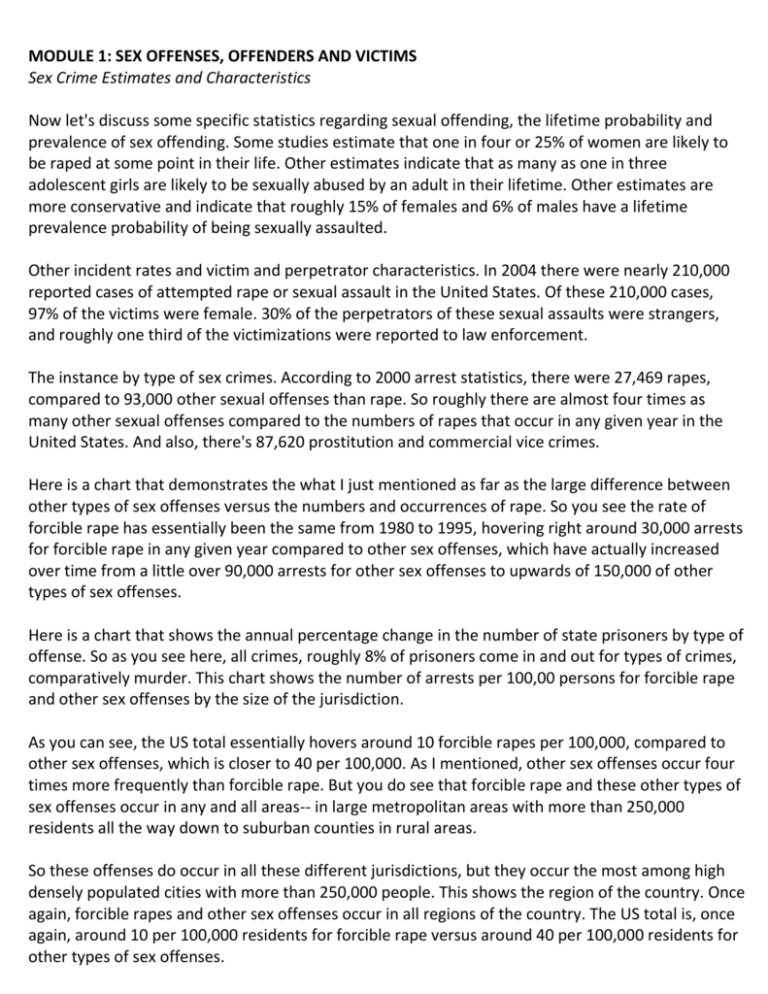
MODULE 1: SEX OFFENSES, OFFENDERS AND VICTIMS
Sex Crime Estimates and Characteristics
Now let's discuss some specific statistics regarding sexual offending, the lifetime probability and
prevalence of sex offending. Some studies estimate that one in four or 25% of women are likely to
be raped at some point in their life. Other estimates indicate that as many as one in three
adolescent girls are likely to be sexually abused by an adult in their lifetime. Other estimates are
more conservative and indicate that roughly 15% of females and 6% of males have a lifetime
prevalence probability of being sexually assaulted.
Other incident rates and victim and perpetrator characteristics. In 2004 there were nearly 210,000
reported cases of attempted rape or sexual assault in the United States. Of these 210,000 cases,
97% of the victims were female. 30% of the perpetrators of these sexual assaults were strangers,
and roughly one third of the victimizations were reported to law enforcement.
The instance by type of sex crimes. According to 2000 arrest statistics, there were 27,469 rapes,
compared to 93,000 other sexual offenses than rape. So roughly there are almost four times as
many other sexual offenses compared to the numbers of rapes that occur in any given year in the
United States. And also, there's 87,620 prostitution and commercial vice crimes.
Here is a chart that demonstrates the what I just mentioned as far as the large difference between
other types of sex offenses versus the numbers and occurrences of rape. So you see the rate of
forcible rape has essentially been the same from 1980 to 1995, hovering right around 30,000 arrests
for forcible rape in any given year compared to other sex offenses, which have actually increased
over time from a little over 90,000 arrests for other sex offenses to upwards of 150,000 of other
types of sex offenses.
Here is a chart that shows the annual percentage change in the number of state prisoners by type of
offense. So as you see here, all crimes, roughly 8% of prisoners come in and out for types of crimes,
comparatively murder. This chart shows the number of arrests per 100,00 persons for forcible rape
and other sex offenses by the size of the jurisdiction.
As you can see, the US total essentially hovers around 10 forcible rapes per 100,000, compared to
other sex offenses, which is closer to 40 per 100,000. As I mentioned, other sex offenses occur four
times more frequently than forcible rape. But you do see that forcible rape and these other types of
sex offenses occur in any and all areas-- in large metropolitan areas with more than 250,000
residents all the way down to suburban counties in rural areas.
So these offenses do occur in all these different jurisdictions, but they occur the most among high
densely populated cities with more than 250,000 people. This shows the region of the country. Once
again, forcible rapes and other sex offenses occur in all regions of the country. The US total is, once
again, around 10 per 100,000 residents for forcible rape versus around 40 per 100,000 residents for
other types of sex offenses.
But you do see that other types of sex offenses occur more frequently in the West followed by the
Midwest. And the South and Northeast are relatively similar in other sex offenses. Forcible rape,
relatively low rate occurrence, which little variability across regions of the country.
This chart shows the locations of sex crimes based on victim reports of rapes and sexual assaults.
You see that the majority of these rapes and sexual assault victimizations were reported to occur at
the victim's home, followed by other locations or at a friend and neighbor's or relative's home,
fewer cases on a street away from home. And the least amount of cases of victimization were
reported in parking lots and garages.
The time of these sex crimes that occurred, particularly for rapes and sexual assaults, the bulk of
these victimizations occurred between 6:00 PM and midnight. 43.4% of these cases occurred
between 6:00 PM and midnight, followed by the daytime, from 6:00 AM to 6:00 PM, which roughly
was responsible for one third of the cases. And then the fewest cases occurred between the hours
of 12 AM midnight and 6:00 AM.
Now, with respect to weapon use, based on data from inmate reports of weapon used when they
committed their sexual assault or rape, and these are all prisoners, keep in mind. So you can see
here that, by and large, for the all column, a little less than half actually used a weapon when they
committed their sex offense, with 45.7%.
Obviously the use of weapons is more frequent in rape cases at 16.6% than it is in other types of
sexual assaults, where only 5.6% of these offenders reported using a weapon. The weapon of choice
is a handgun for sex offenses, with 24.2% reporting a handgun, followed by a knife, other type of
firearm, or other type of weapon. But, once again, looking at the very last row, more than half did
not use a weapon in the commission of their offense.
So to recap, about 2/3 of rapes/sexual assaults occur between 6:00 PM and 6:00 AM. Nearly six out
of 10 rapes/sexual assaults occurred in the victim's own residence, home, or at the home of a
friend, relative, or a neighbor. More than half of the rape/sexual assaults that occurred occurred
within one mile of the victim's home or at their home. And only about one of every 16 reported
sexual assault victimizations the offender reported a firearm was used.
Here's a nice graphical display that shows you the offender age crime curve. So age is plotted on the
axis at the bottom, and the vertical axis shows the rate per 1,000 offenders. So as you can see here,
the rate of sexual assault offenders in the United States increases as age increases, particularly from
age five all the way up to age 14.
After this peak at age 14, the rate of sexual offenders in the offender population decreases after age
14 all the way until age 60. So essentially you have one peak in age 14, which means the highest rate
for sexual offenders is at age 14.
Here we have a figure of the victim age crime curve. The previous curve was the offender age crime
curve. This is the victim age crime curve. So what we see here, similarly, the rate of sexual assaults
per victims increases from essentially an infant at age one up to a peak at age four.
Then it dips slightly between ages five and 10 before increasing again and peaking once again at age
14. And then past age 14, there's a precipitous decline down to age 60. So although we only saw
one peak in the offender age curve at age 14, we see two peaks among the victim age curve, one at
age four and one at age 14.
Now, when you split the victim age curve that we just looked at by gender or biological sex, you see
some stark differences but some similarities. Essentially, the age crime curve for male victims
increases from when they're an infant, peaks at age four just like it does for females. But it declines
throughout the next 10 or 15 years or so essentially to being almost a rate close to zero when
they're young adults.
Where females, there is an additional peak at age 14. And although their rate declines after age 14,
they still have a relatively large rate of occurrence compared to males. So females are more likely to
be victims of sexual assaults than males.
Some statistics regarding the sentencing of these offenders who are sentenced for sexual assault, in
2002, there were 26,000 adult convictions for sexual assault or rape. 84% of these 26,000
convictions, these offenders were sent to jail or prison. The average sentence length imposed upon
these offenders for rapes and sexual assault were six years and eight months.
But overall, once again keep in mind that thankfully rape and sexual assault is a rare occurrence. So
therefore these offenders make up a very small percentage of the overall offender pool in prison.
Specifically, rape and sexual assault offenders represent close to 5% of the overall correctional
population.
So recognizing they comprise a small portion of the overall offender population in prison, if you look
at convicted sex offenders in general, the majority of these convicted sex offenders are on
probation, which means they are out in the community, followed by state and federal prisons, on
parole, which also means they are in the community, and some, the small percentage, are in local
jails.
So what you need to take from this is that the majority of convicted sex offenders are not
incarcerated. They're actually under community supervision, either via probation or parole.






